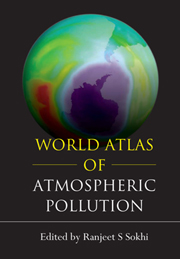Book contents
- Frontmatter
- Contents
- Contributors
- Foreword
- Preface
- Acknowledgements
- International Union of Air Pollution Prevention and Environmental Protection Associations (IUAPPA)
- Global Atmospheric Pollution (GAP) Forum
- Acronyms and Abbreviations
- Selected Units Used in Atmospheric Pollution Science
- INTRODUCTION
- CHAPTER 1 AIR POLLUTION HISTORY
- CHAPTER 2 AIR POLLUTION IN URBAN AREAS
- CHAPTER 3 LONG-RANGE TRANSPORT OF ATMOSPHERIC POLLUTANTS AND TRANSBOUNDARY POLLUTION
- CHAPTER 4 GLOBAL AIR POLLUTION AND CLIMATE CHANGE
- CHAPTER 5 OZONE DEPLETION
- CHAPTER 6 ENVIRONMENTAL AND HEALTH IMPACTS OF AIR POLLUTION
- CHAPTER 7 FUTURE TRENDS IN AIR POLLUTION
- References
- List of Useful Reading Material
- Index
CHAPTER 3 - LONG-RANGE TRANSPORT OF ATMOSPHERIC POLLUTANTS AND TRANSBOUNDARY POLLUTION
Published online by Cambridge University Press: 05 March 2012
- Frontmatter
- Contents
- Contributors
- Foreword
- Preface
- Acknowledgements
- International Union of Air Pollution Prevention and Environmental Protection Associations (IUAPPA)
- Global Atmospheric Pollution (GAP) Forum
- Acronyms and Abbreviations
- Selected Units Used in Atmospheric Pollution Science
- INTRODUCTION
- CHAPTER 1 AIR POLLUTION HISTORY
- CHAPTER 2 AIR POLLUTION IN URBAN AREAS
- CHAPTER 3 LONG-RANGE TRANSPORT OF ATMOSPHERIC POLLUTANTS AND TRANSBOUNDARY POLLUTION
- CHAPTER 4 GLOBAL AIR POLLUTION AND CLIMATE CHANGE
- CHAPTER 5 OZONE DEPLETION
- CHAPTER 6 ENVIRONMENTAL AND HEALTH IMPACTS OF AIR POLLUTION
- CHAPTER 7 FUTURE TRENDS IN AIR POLLUTION
- References
- List of Useful Reading Material
- Index
Summary
Early air pollution control efforts were prompted by urban episodes due to local emissions, such as the 1952 London smog associated with sulphur from burning coal (see Chapter 1). Although local areas typically experience the highest levels of health- and ecosystemdamaging air pollution, many species remain in the atmosphere for days, months, or even years. The longer a pollutant stays in the atmosphere, the farther from its original source it travels. For example, it takes about five days for a pollutant to cross the Pacific Ocean, but over a year for pollution to cross from the Northern Hemisphere mid-latitudes to the Southern Hemisphere. An example of such a pollutant plume as seen by satellite is shown in Figure 3.1.
Regional Air Pollution Transport
Although early scientific and regulatory efforts focused on local emissions and local effects, since the late 1970s, the geographic scale on which pollutant transport is studied and regulated has expanded. In Europe, the UNECE Convention on Long-Range Transbounday Air Pollution (LTRAP, www.unece. org/env/lrtap) came into force in 1983, driven by a concern about acid rain in Europe, and it has since expanded to address nitrogen deposition, ozone, heavy metals, particulate matter, and persistent organic pollutants (POPs). Scientific support for the Convention is provided through the Cooperative Programme for Monitoring and Evaluation of the Long-Range Transmission of Air Pollutants in Europe (EMEP), which assesses air pollution impacts on Europe.
- Type
- Chapter
- Information
- World Atlas of Atmospheric Pollution , pp. 35 - 46Publisher: Anthem PressPrint publication year: 2008



